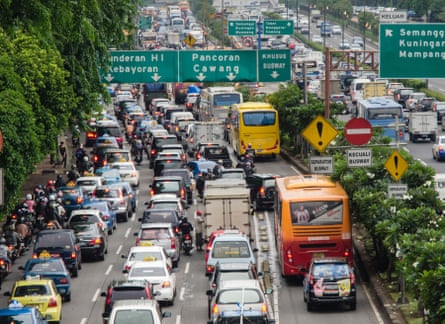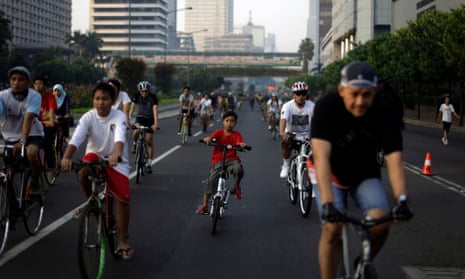For five hours every Sunday, the usual chaos of cars, clapped-out buses and swarms of motorcycles is absent from the heart of Jakarta. Instead, cyclists rule the roads. On Jalan Jenderal Sudirman, one of the city’s main thoroughfares, they turn out in droves. Riders dressed in sportswear and tight-fitting lycra fly past. Young children, with parents at their side, wobble and swerve down the flat, sunbaked street.
For a city that was recently named the world’s most congested, according to one survey, it’s a heartening view – but Jakarta’s weekly car-free day couldn’t be further from day-to-day reality. Ask a cyclist what it’s like to ride in Indonesia’s capital – a sprawling megalopolis of 10.2 million people – and, if they’re generous, they’ll say it’s challenging or possible. More than likely, though, they’ll tell you it’s outright dangerous.
From early morning through to late in the evening, the city is snared in semi-permanent gridlock. A total of 17.5 million motorised vehicles are estimated to be on Jakarta’s roads, with 98% of them private motorbikes, cars and lorries. The central government has calculated that congestion costs the city 65 trillion rupiahs a year (£3bn), and air pollution is considered a major health issue. All that makes for a particularly inhospitable environment to pedal through.

“People don’t want to cycle in Jakarta because the traffic is very dangerous,” says cyclist Toto Sugrito, chairman and co-founder of Bike2Work Indonesia.
The 52-year-old is one of a small number of cycling campaigners who, against the odds, are trying to turn Jakarta into a cycle-friendly city. Sugrito established Bike2Work, which advocates for the use of cycling as a form of sustainable transport, in 2004. There are now more than 130 chapters across Indonesia and more than 5,000 members in Jakarta.
“I have a dream that Jakarta should be like Copenhagen,” he says, sitting in a meeting room at his architecture firm in Tebet, in the south of the city. “Nothing is impossible. I don’t want to limit our dream to make a better Jakarta.”
Car-free days may be popular, but there is almost no infrastructure for cyclists and spotting someone riding a bike in peak hour traffic is rare.

Jakarta’s three cycle ways are effectively useless, cyclists say. The lanes are ignored and overrun with motorcycles and cars; they also lack connectivity with each other or the city’s TransJakarta bus way. There are no bike sharing facilities – although at least two have been proposed – and few workplaces are equipped with amenities such as showers, a major issue when cycling through heavy traffic in temperatures that hover around 30C.
Still, getting Jakartans to give up motorised transport for bicycles isn’t impossible, Sugrito says. He points to Colombia’s capital, Bogotá, as a city that successfully tackled crippling traffic jams and increased bicycle use by introducing a range of sustainable transport policies. Like Jakarta, Bogotá’s transportation system was once dominated by privately owned motorised transport and an uncoordinated network of competing bus companies.
That changed in the late 1990s when former mayor Enrique Peñalosa started work on a large-scale bus rapid transport system (BRT) and introduced a number of pro-cycling policies, including an extensive network of cycle lanes. As a result, bicycle use jumped and Bogotá is now a poster city for sustainable transport.
While Bogotá benefited from a series of forward-thinking mayors, trying to convince the Jakarta City Council to implement pro-cycling policies is a struggle, according to Jakarta-based transport specialist Yoga Adiwinarto.

Adiwinarto, the Indonesian country director for the Institute for Transportation and Development Policy (ITDP), says the mindset of Indonesian provincial authorities still heavily favours motorised transportation.
“Cars have the first priority, then motorcycles,” he says.
The ITDP has developed a bike-sharing plan for Jakarta which would provide 2,000 bicycles at more than 100 stations across the city. The organisation has estimated it would cost between £2.5m and £4m for the facilities, with private sector involvement likely, and would require another £2.5m in investment from the provincial government to provide cycling corridors, publicise cycling routes and improve safety around intersections.
Adiwinarto says there has been interest in the proposal from the private sector, but when it was presented to councillors in 2013, they were not prepared to fund it.
“It’s really important for Jakarta to realise that the future is with walking and cycling,” he says. “If we can’t reduce congestion it will become an unproductive city.”
The population of the greater Jakarta area is expected to increase from about 27 million today to more than 40 million by 2040, partly as a result of urbanisation.
With the number of vehicles on the streets growing at about 12% annually (an average increase of 4,000 motorbikes and 1,500 cars a day, according to Pola Metro Jaya, the Jakarta police), and roads being constructed at a fraction of the pace, public transportation is a priority. Improving the city’s BRT, starting work on a light rail transit system and finishing the long-delayed mass rapid transport (MRT) system are seen as the three key long-term transport fixes. Introducing stricter traffic control measures, such as electronic road pricing, and enforcing motorcycle restrictions, are also part of the effort to ease pressure on the city’s overstretched roads.

There is hope among cyclists that bike lanes will become a priority after the city’s MRT system is finished in 2019. In the meantime, several young innovators are taking matters into their own hands.
At the New Cities Summit 2015 in June, two finalists won over judges in the Jakarta Urban Challenge with solutions to improve the city’s traffic woes and cut pollution. Both could make cycling on Jakarta’s car-choked streets more appealing.
The Cyclist Urban System wants to create dedicated cyclist hubs across Jakarta, where cyclists can securely park their bikes, shower and get dressed, as well as carry out repairs and obtain route information.
The Squee Mobile App, meanwhile, aims to link pedestrians and cyclists to travel together on quieter, non-motorised routes in Jakarta’s urban villages. The navigation app, which was awarded the contest’s grand prize, also allows users to alert other commuters to potential hazards, like crashes or unsafe areas.
Both initiatives, which are still being developed, have been well-received by Jakarta governor Basuki Tjahaja Purnama, who says they could help get more people from their homes to public transport hubs and has offered technical support.
But transforming Jakarta into a cycle-friendly city is going to take more than that. Khairunnisa Kautsar, one of three friends behind the Cyclist Urban System, says people in Jakarta are fed up with traffic jams and want to see alternatives to cars and motorcycles. The bicycle, she says, is the most sustainable alternative.
“You see at car-free day there are many cyclists, but during the weekdays you don’t see them. We see the potential because we have a community of cyclists here, an emerging community. But the government has to facilitate that.”
Follow Guardian Cities on Twitter and Facebook and join the discussion

Comments (…)
Sign in or create your Guardian account to join the discussion